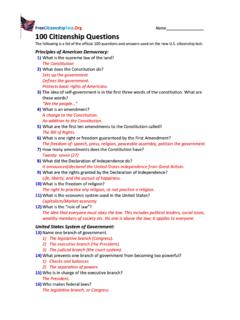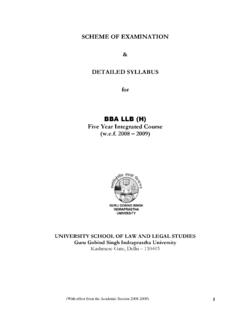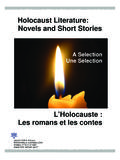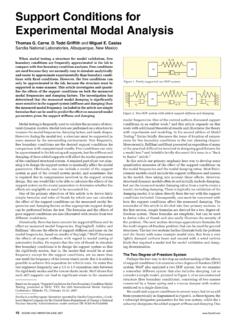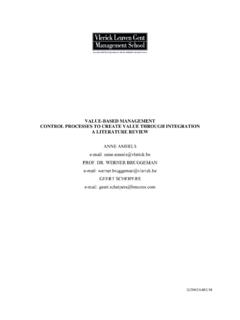Transcription of AITH INGGOLD HRONOLOGY - Faith Ringgold
1 FA I T H R I N G G O L D C H R O N O LO G Y. 1930 Born October 8 at Harlem Hospital, New York City, to Andrew Louis Jones Sr. and Willi Posey Jones. Faith has two older siblings, Andrew and Barbara. She is frequently sick with asthma as a small child; art becomes a major pastime. 1942 Ringgold 's family moves from the Valley to Sugar Hill in Harlem. 1950 Marries Robert Earl Wallace, a classical and jazz pianist, while majoring in art at the City College of New York. Obtains first studio space for independent oil painting pro- jects in their apartment at 365 Edgecombe Avenue. 1952 Has two children: Michele Faith Wallace, January 4; Barbara Faith Wallace, December 15.
2 1954 Permanent separation and divorce proceedings begin, completed in 1956. 1955 Graduates from the City College of New York with a BS in Fine Art and Education. Begins teaching art in the New York City public schools (1955 1973). It is at this time that Faith first hears about James Baldwin, through his younger sister, Paula, who was a student of Faith 's. 1957 Spends the first of many summers in Provincetown, Massachusetts, rendering oil paint- ings of houses, landscapes, fishing boats, and the ocean. 1959 Completes an MA in Art at the City College of New York. 1961 Takes her first trip to Europe (with her mother and her daughters) aboard the Libert.
3 Tours the museums in Paris, Nice, Florence, and Rome. Her brother Andrew dies while they are in Rome, so they abruptly return to the United States. Faith 's dining area in her home becomes her studio space. 1962 Marries Burdette Ringgold , May 19. 1963 Does her first political paintings. During a summer spent at Oaks Bluff on Martha's Vineyard, Faith develops her first mature painting style; the content is influenced by the writings of James Baldwin and Amiri Baraka (then Leroi Jones) the artist calls her style super realism. Begins painting The American People Series of oil paintings (1963 1967).
4 1964 Begins a search for a New York Gallery. She writes letters to Romare Bearden and Hale Woodruff in an attempt to join Spiral, the black artists group, and to exhibit in the first Black Arts Festival in Senegal, but is unsuccessful in both instances. 1965 Meets Leroi Jones at his Black Arts Repertory Theatre and School in Harlem. 1966 Participates in the first black exhibition held in Harlem since the 1930s. Meets Romare Bearden, Ernie Crichlow, Norman Lewis, Charles Alston, Hale Woodruff, Betty Blay- ton her first real contact with black artists. Joins Spectrum Gallery on 57 Street.
5 Robert Newman is the director. 1967 Paints her first murals, The Flag Is Bleeding, Postage Stamp Commemorating the Advent of Black Power, and Die, while her daughters are in Europe for the summer. Holds her first one-person show at Spectrum Gallery. Meets James Porter of Howard University, who buys a painting from The American People Series. Begins development of black light, in which she uses a palette of darkened colors, in pursuit of a more affirmative black aesthetic. 1968 Participates in a benefit exhibition for Martin Luther King Jr. at the Museum of Modern Art. Meets Jacob Lawrence, Henri Ghent, and Ed Taylor.
6 Initiates first demon- stration of black artists at the Whitney Museum. Joins Art Workers Coalition. Meets Lucy Lippard, Carl Andre, and Lil Picard. Demonstrates with Tom Lloyd, a light sculp- tor, against MoMA to achieve a black artist wing named after Martin Luther King Jr. Instead, their efforts result in two blacks being appointed to the Board of Trustees of the museum and major exhibitions for two black artists at MoMA in 1971. 1969 Paints Flag for the Moon: Die Nigger as a response to the first moon shot. Begins a series of political posters. Her daughters are in Mexico for the summer; her father dies.
7 1970 Has second one-person show: America Black, featuring her black light paintings, at Spec- trum Gallery. Begins teaching at Bank Street, Pratt Institute, and Wagner College. Meets Robert Morris and Poppy Johnson through Art Strike. Participates in demonstra- tions of the Ad Hoc Women's Art Group against the Whitney Museum. Her particular contributions result in the inclusion of Betye Saar and Barbara Chase-Riboud in the Whitney Sculpture Biennial, making them the first black women ever to exhibit at the Whitney. Creates her first dolls, The Family of Woman Masks, and The Slave Rape Series of paintings.
8 Collaborates with her mother, Willi Posey (a fashion designer), on cos- tumes for masks and thangkas for paintings. 1971 Cofounds Where We At, a black artists group. Serves as guest curator of a Where We At show at Acts of Art Gallery. Meets Kay Brown and Dinga McCannon. Creates the United States of Attica poster. Wins a CAPS Grant to do a mural for The Women's House of Detention. As a result of being on the television show On Free Time (PBS), hosted by Julius Lester, she meets Louise Nevelson, Alice Neel, and Pat Mainardi. 1972 For the Women's House, in which Faith first uses all-female imagery, is permanently installed at the Women's House of Detention on Riker's Island.
9 As a result, Art Without Walls (an artists group dedicated to bringing art to prison inmates) is formed. Develops thangkas (soft cloth frames) after viewing an exhibition of Tibetan art at the Rijk Museum in Amsterdam. Puts political posters and feminist papers in Documenta in Kassel, Germany. Participates in the First American Women Artists Show in Hamburg. Begins lecture tours and traveling exhibitions to colleges and universities around the United States. 1973 A ten-year retrospective of the artist's work is held at Voorhees Gallery at Rutgers University. She resigns from her teaching position in the New York City public school system to continue touring and to create art full time.
10 She does her first dolls, The Family of Woman Series. 1974 Develops hanging soft sculptures, Wilt and Couple series; both series feature painted coconut heads. Does The Windows of the Wedding Series, abstract paintings based on African Kuba design, and uses them as the environment for soft sculptures. Her daugh- ter Michele graduates from City College; Barbara completes her senior year of college at the University of London. 104 Chronology 1975 Curates 11 in New York, a black women's show held at the Women's Interarts Center. Begins to do art performances with masks and costumes. Creates her first stuffed figures, Zora & Fish (bagman and woman), and the first portrait masks of The Harlem Series, which includes Adam Clayton Powell Jr.

